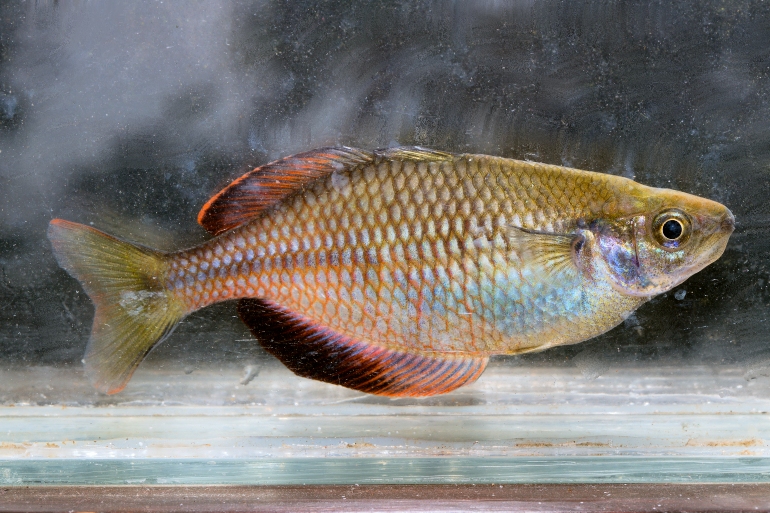|
 |
Melanotaenia sneideri (wild-caught) - photo© Mikael Håkansson |
Allen and Hadiaty, 2013
Kumawa Rainbowfish
Species Summary
The colour of mature males of Melanotaenia sneideri is blue-grey with broad red scale margins, imparting an overall rich-red appearance over most of the body; head mainly grey-blue except light greenish dorsally, grading to whitish ventrally with reddish chin; dorsal anal, and pelvic-fins dark brown to blackish; second dorsal-fin with orange-red outer margin; caudal-fin pinkish-orange; pectoral-fins translucent.
Adult males are easily distinguished on the basis of the overall red colouration, which is lacking in females. Similar to most Melanotaenia, males are also deeper bodied than females. Unlike most members of the genus, which have a more elongate, pointed shape posteriorly on the soft dorsal and anal fins of males, the male of M. sneideri has a more evenly rounded anal-fin profile, with the longest rays in the middle portion of the fin. This feature is shared by several members of the genus from the Bird's Head Peninsula including M. ammeri, M. irianjaya, M. kokasensis and M. parva.
Melanotaenia sneideri is separable from all other members of the genus and most melanotaeniids on the basis of the unique male colouration. Only Glossolepis incisus possesses a substantial amount of red on the body of adult males. Melanotaenia parva from Lake Kurumoi, West Papua is also known to develop a bright red colour in captivity, in contrast to the mainly bluish to mauve hue of wild-caught fish. The adult male of M. sneideri is also separable from all congeners by the dark brown to blackish colour of the dorsal, anal, and pelvic fins. The maximum body depth (at least 42.3% of SL) attained by adult males further distinguishes it from most other Melanotaenia from the Bird's Head region, which generally have values less than 40%. Notable exceptions are M. ajamaruensis, M. angfa, M. boesemani, M. kamaka and M. lakamora. All of these species except M. angfa inhabit lacustrine environments. Although there are a few exceptions, lacustrine species of Chilatherina, Glossolepis, and Melanotaenia, generally have deeper bodied males than stream-dwelling species. The more slender shape of fish from lotic habitats is probably a hydro-dynamic adaptation to swift-flowing water. It is interesting to note that a deeper-bodied shape is frequently assumed in aquarium-bred specimens of lotic species compared to individuals of the same species in nature.
Although the largest collected specimen of M. sneideri was 80.1 mm SL, the species attains a much larger size. One specimen, 110 mm SL was collected, but unfortunately discarded due to the lack of a sufficient-sized preservation container. This is one of the three largest known species from the Bird's Head Peninsula. Only M. fasinensis (120 mm SL) and M. angfa (114 mm SL) are known to attain a larger size. Other noteworthy features that further distinguish this species from most Melanotaenia include the combination of 15-16 circumpeduncular scales and 18-20 total gill rakers on the first branchial arch, both values that are relatively high for the genus compared to counts of 11-14 and 13-18 respectively for most other species.
Distribution & Habitat
The only know location of Melanotaenia sneideri so far is situated in the Kumawa Mountains at the southern extremity of the Bomberai Peninsula of West Papua, and consist of three sets of peaks exceeding 1400 metres in elevation. The location, which lies at an altitude of 1050 metres, consists of a small ephemeral lake basin, approximately 1000 metres in length and 600 metres wide. During dry periods it consists of a small creek that emerges from limestone rocks on the edge of the basin and flows for 500-600 metres before draining underground. The maximum width of this remarkably clear creek varies from about 1-2 metres, with a maximum depth of 30-50 cm and average depth of about 10-20 cm. During a visit in early March 2013, most fish, particularly large adults were concentrated in rocky pools near the end of the creek, just before it disappeared into the ground. However, conditions had changed dramatically due to heavy rainfall during a second visit in late March. The creek was then inundated, forming a small lake and the fish were consequently more widely dispersed.
The eastern-most part of the region consists of flat alluvial lowlands, while the southern slopes of the mountains are especially steep. Most of the area is covered in moist lowland forest and montane forest. Wetland habitats include coastal mangroves, beach vegetation, a marsh at 600 metres elevation three kilometres east of the northern most peak, and two freshwater lakes at an elevation of 1200 metres three kilometres south of the northern most peak.
Remarks
This species was named in honour of Dr. Richard Sneider, whom, together with Max Ammer planned and executed the 2013 Kumawa Mountains Expedition. Richard Sneider discovered the species, photographed and filmed it, and, with Obed Holago, first collected the type specimens.
Literature
Allen G.R. and R.K. Hadiaty (2013) Melanotaenia sneideri, a New Species of Rainbowfish (Melanotaeniidae), from West Papua Province, Indonesia. aqua, International Journal of Ichthyology 19(3): 137-146.
Adrian R. Tappin
Updated April, 2015



|
|

